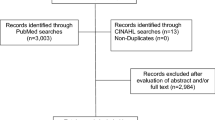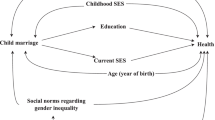Abstract
Purpose
Breast cancer, a common malignancy in Indian women, is preventable and curable upon early diagnosis. Screening is the best control strategy against breast cancer, but its uptake is low in India despite dedicated strategies and programmes. We explored the impact of socio-cultural and financial issues on the uptake of breast cancer screening behaviour among Indian women.
Methods
Breast cancer screening-uptake and relevant social, cultural, and financial data obtained from the National Family Health Survey (NFHS) round 5 were used for analysis. We studied 399,039 eligible females to assess their breast cancer screening behavior and determine the impact of socio-cultural and financial issues on such behavior using multivariable logistic regression.
Results
Most participants were 30–34-year-old (27.8%), educated to the secondary level (38.0%), and 81.5% had bank accounts. A third (35.0%) had health insurance, and anaemia was the most common comorbidity (56.1%). Less than 1.0% had undergone breast cancer screening. Higher age, education, urban residence, employment, less privileged social class, and access to the Internet and mass media were predictors of positive screening-uptake behavior (p < 0.05). Mothers of larger number of children, tobacco- and alcohol-users, the richer and having health insurance had negative uptake behavior (p < 0.05).
Conclusion
A clear impact of socio-cultural and financial factors on breast cancer screening behavior is evident among Indian women. Therefore, apart from the ongoing health system strengthening efforts, our findings call for targeted interventions against prevailing misconceptions and taboos along with economic and social empowerment of women for the holistic success of India’s cancer screening strategy.

Similar content being viewed by others
Data availability
Enquiries about data availability should be directed to the authors.
References
Office of the Registrar General, India (2021) Report on medical certification of cause of death 2018. Office of the Registrar General, India. https://censusindia.gov.in/2011-Documents/mccd_Report1/MCCD_Report-2018.pdf
International Agency for Research on Cancer, World Health Organization (2022) Cancer today. http://gco.iarc.fr/today/home
Indian Council of Medical Research (2022) Cancer statistics. India against cancer. http://cancerindia.org.in/cancer-statistics/
World Health Organization (2021) Breast cancer. https://www.who.int/news-room/fact-sheets/detail/breast-cancer
Breast Cancer India (2021) https://www.breastcancerindia.net/
Economist Intelligence Unit (2009) Breakway: the global burden of cancer—challenges and opportunities. Economist intelligence unit
World Health Organization (2022) Cervical cancer elimination initiative. https://www.who.int/initiatives/cervical-cancer-elimination-initiative
World Health Organization (2022) A cervical cancer-free future: First-ever global commitment to eliminate a cancer. https://www.who.int/news/item/17-11-2020-a-cervical-cancer-free-future-first-ever-global-commitment-to-eliminate-a-cancer
Dhakal R, Noula M, Roupa Z, Yamasaki EN (2022) A scoping review on the status of female breast cancer in Asia with a special focus on Nepal. BCTT 26(14):229–246
Agrawal A, Tripathi P, Sahu A, Daftary J (2014) Breast screening revisited. J Family Med Prim Care 3(4):340–344
Fan L, Goss PE, Strasser-Weippl K (2015) Current status and future projections of breast cancer in Asia. BRC 10(6):372–378
Das S, Patro K (2010) Cancer care in the rural areas of India: a firsthand experience of a clinical oncologist and review of literatures. J Can Res Ther 6:299–303
Bagcchi S (2016) India launches plan for national cancer screening programme. BMJ 17(355):i5574
Ministry of Health & Family Welfare, Government of India (2016) Operational Framework Management of Common Cancers. https://main.mohfw.gov.in/sites/default/files/Operational%20Framework%20Management%20of%20Common%20Cancers_1.pdf
Government programme for non-communicable diseases renamed (2023) The Hindu. https://www.thehindu.com/sci-tech/health/new-diseases-and-initiatives-prompt-health-ministry-to-widen-and-rename-ncd-programme/article66816673.ece
Smith RD, Mallath MK (2019) History of the growing burden of cancer in India: from antiquity to the 21st century. JGO 5:1–15
Sharma P (2022) India’s cancer burden to rise to 29.8 million in 2025: ICMR report. Mint. https://www.livemint.com/science/health/indias-cancer-burden-to-rise-to-29-8-million-in-2025-icmr-report-11652382169284.html
Gakidou E, Nordhagen S, Obermeyer Z (2008) Coverage of cervical cancer screening in 57 countries: low average levels and large inequalities. PLoS Med 5(6):e132
Ministry of Health & Family Welfare, Government of India (2022) National family health survey (NFHS—5), 2019–21. Mumbai: International Institute of Population Sciences
International Agency for Research on Cancer, World Health Organization (2022) Cervical cancer screening. Vol. 18. Lyon. https://publications.iarc.fr/Book-And-Report-Series/Iarc-Handbooks-Of-Cancer-Prevention/Cervical-Cancer-Screening-2022
World Health Organization (2022) Cervical cancer screening. https://www.who.int/data/gho/indicator-metadata-registry/imr-details/3240
Child marriage (2022) https://www.unicef.org/protection/child-marriage
Parkin DM, Bray F, Ferlay J, Pisani P (2005) Global cancer statistics, 2002. Cancer J Clin 55(2):74–108
Eurostat (2022) Healthcare activities statistics—preventive services. https://ec.europa.eu/eurostat/statistics-explained/index.php?title=Healthcare_activities_statistics_-_preventive_services
Campbell NC, Elliott AM, Sharp L, Ritchie LD, Cassidy J, Little J (2001) Rural and urban differences in stage at diagnosis of colorectal and lung cancers. Br J Cancer 84(7):910–914
Dinshaw K, Shastri S, Patil S (2005) Cancer control programme in India: Challenges for the new millennium. Health Adm 17:10–13
da Costa Vieira RA, Biller G, Uemura G, Ruiz CA, Curado MP (2017) Breast cancer screening in developing countries. Clinics 72(4):244–253
Somdatta P, Baridalyne N (2008) Awareness of breast cancer in women of an urban resettlement colony. Indian J Cancer 45(4):149–153
Changkun Z, Bishwajit G, Ji L, Tang S (2022) Sociodemographic correlates of cervix, breast and oral cancer screening among Indian women. PLoS ONE 17(5):e0265881
Aswathy S, Quereshi MA, Kurian B, Leelamoni K (2012) Cervical cancer screening: current knowledge & practice among women in a rural population of Kerala. India Indian J Med Res 136(2):205–210
Thahirabanuibrahim I, Logaraj M (2021) Impact of health education intervention in promoting cervical cancer screening among rural women of Chengalpattu district—the community based interventional study. Clin Epidemiol Global Health 12:100895
Cancer Awareness (2013) Join the fight against cancer. https://www.indiancancersociety.org/what-do-we-do/awareness
Coffey P, Arrossi S, Bradley J, Dzuba I, White S (2004) ACCP community involvement affinity group. improving screening coverage rates of cervical cancer prevention programs: a focus on communities. Seattle, WA, USA: Alliance for Cervical Cancer Prevention. https://screening.iarc.fr/doc/RH_accp_improve_screening.pdf
Roy B, Tang TS (2008) Cervical cancer screening in Kolkata, India: beliefs and predictors of cervical cancer screening among women attending a women’s health clinic in Kolkata. India J Cancer Educ 23(4):253–259
Department of Women Development & Social Welfare, Government of West Bengal (2022) Kanyashree. https://www.wbkanyashree.gov.in/kp_4.0/index.php
Ministry of Women & Child Development, Government of India (2022) Beti Bachao Beti Padhao. https://wcd.nic.in/bbbp-schemes
Sherris J, Wittet S, Kleine A, Sellors J, Luciani S, Sankaranarayanan R et al (2009) Evidence-based, alternative cervical cancer screening approaches in low-resource settings. Int Perspect Sex Reprod Health 35(3):147–154
Seow A, Wong ML, Smith WC, Lee HP (1995) Beliefs and attitudes as determinants of cervical cancer screening: a community-based study in Singapore. Prev Med 24(2):134–141
Croce MV, Cermignani L, Rabassa ME (2020) Abstract 1130: cultural and socioeconomic factors affecting breast cancer screening in an Argentine city. Cancer Res 80(16_Supplement):1130–1130
Bradley J, Risi L, Denny L (2004) Widening the cervical cancer screening net in a South African township: who are the underserved? Health Care Women Int 25(3):227–241
Institute of Medicine (US) Committee on Assuring the Health of the Public in the 21st Century (2002) The Future of the Public’s Health in the 21st Century. The Future of the Public’s Health in the 21st Century. Washington DC, USA: National Academies Press (US). https://www.ncbi.nlm.nih.gov/books/NBK221224/
Smith CF, Whitaker KL, Winstanley K, Wardle J (2016) Smokers are less likely than non-smokers to seek help for a lung cancer ‘alarm’ symptom. Thorax 71(7):659–661
Li C, Sun J (2022) The impact of current smoking, regular drinking, and physical inactivity on health care-seeking behavior in China. BMC Health Serv Res 22(1):52
What are the reasons & consequences of not buying health insurance Plans? Digit insurance. https://www.godigit.com/content/godigit/directportal/en/homepage.html
American Cancer Society (2023) Keeping up with health insurance during cancer treatment. https://www.cancer.org/cancer/financial-insurance-matters/managing-health-insurance/managing-health-insurance-when-someone-has-cancer.html
India Today (2023) Cancer cover in health insurance: 5 things you need to know. India Today. https://www.indiatoday.in/business/story/cancer-cover-in-health-insurance-5-things-you-need-to-know-1930504-2022-03-28
Zhao G, Okoro CA, Li J, Town M (2018) Health insurance status and clinical cancer screenings among U.S. adults. Am J Prev Med 54(1):e11-9
Department of Health and Family Welfare, Government of West Bengal (2021) Swasthya Sathi. https://swasthyasathi.gov.in/
Agberen A (2023) Effect of wealth on health care seeking behavior and out of pocket health expenditure in Malawi [Thesis]. University of Washington; 2016. https://digital.lib.washington.edu:443/researchworks/handle/1773/36987
Meer J, Miller DL, Rosen HS (2003) Exploring the health—wealth nexus. J Health Econ 22(5):713–730
Hamzelou J (2017) Wealth can’t always buy health. New Sci 15:11
Dhillon PK, Hallowell BD, Agrawal S, Ghosh A, Yadav A, Van Dyne E et al (2020) Is India’s public health care system prepared for cervical cancer screening?: Evaluating facility readiness from the fourth round of the District Level Household and Facility Survey (DLHS-4). Prev Med 1(138):106147
Kedar A, Kannan R, Mehrotra R, Hariprasad R (2019) Implementation of population-based cancer screening program in a pilot study from india: views from health personnel. Indian J Commun Med 44(1):68–70
Ministry of Health and Family Welfare, Government of India (2022) Official Website Ayushman Bharat | HWC. http://ab-hwc.nhp.gov.in/
Dsouza JP, Van den Broucke S, Pattanshetty S, Dhoore W (2022) Cervical cancer screening status and implementation challenges: report from selected states of India. Int J Health Plan Manage 37(2):824–838
Verma AK (2020) Understanding and managing cancer needs through the kaleidoscope of culture. Cancer forum. https://search.informit.org/doi/abs/https://doi.org/10.3316/informit.442632900042696
Swihart DL, Yarrarapu SNS, Martin RL (2022) Cultural religious competence in clinical practice. In: StatPearls. Treasure Island (FL): StatPearls Publishing. http://www.ncbi.nlm.nih.gov/books/NBK493216/
Rumun A (2014) Influence of religious beliefs on healthcare practices. Int J Educ Res 2(4):37–48
Underwood SM, Powell RL (2006) Religion and spirituality: influence on health/risk behavior and cancer screening behavior of African Americans. ABNF J 17(1):20–31
Ell KO, Mantell JE, Hamovitch MB (1988) Socioculturally sensitive intervention for patients with cancer. J Psychosoc Oncol 6(3–4):141–155
Kinnaird V, Momsen J (1993) Different places, different voices: gender and development in Africa, Asia and Latin America. 1st edition. London: Routledge. https://www.taylorfrancis.com/books/9781134904020
Senarath U, Gunawardena NS (2009) Women’s autonomy in decision making for health care in South Asia. Asia Pac J Public Health 21(2):137–43
School of Public Health and Tropical Medicine, Tulane University (2021) How to improve cultural competence in health care. https://publichealth.tulane.edu/blog/cultural-competence-in-health-care/
Williams JS, Walker RJ, Egede LE (2016) Achieving equity in an evolving healthcare system: opportunities and challenges. Am J Med Sci 351(1):33–43
Schliemann D, Su TT, Paramasivam D, Somasundaram S, Ibrahim Tamin NSB, Dahlui M et al (2019) The systematic cultural adaptation of a UK public health cancer awareness raising programme for Malaysia: the Be Cancer Alert Campaign. Transl Behav Med 9(6):1087–1099
Funding
The authors declare that no funds, grants, or other support was received during the preparation of this manuscript.
Author information
Authors and Affiliations
Contributions
SGP: conceptualization, data curation, formal analysis, methodology, project administration, writing—original draft. SSG: conceptualization, data curation, writing—original draft. AD: supervision, writing—review and editing. RB: project administration, visualization, writing—review and editing. SGL: methodology, supervision, writing—review and editing.
Corresponding author
Ethics declarations
Conflict of interest
The authors have no relevant financial or non-financial interests to disclose.
Additional information
Publisher's Note
Springer Nature remains neutral with regard to jurisdictional claims in published maps and institutional affiliations.
Rights and permissions
Springer Nature or its licensor (e.g. a society or other partner) holds exclusive rights to this article under a publishing agreement with the author(s) or other rightsholder(s); author self-archiving of the accepted manuscript version of this article is solely governed by the terms of such publishing agreement and applicable law.
About this article
Cite this article
Gupta, S., Sinha Gupta, S., De, A. et al. Socio-cultural and financial issues against breast cancer screening behaviour among eligible Indian women: evidence for action. Breast Cancer Res Treat 205, 169–179 (2024). https://doi.org/10.1007/s10549-024-07244-7
Received:
Accepted:
Published:
Issue Date:
DOI: https://doi.org/10.1007/s10549-024-07244-7




